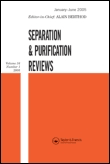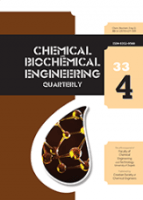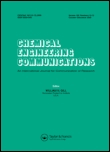
SEPARATION AND PURIFICATION REVIEWS
Scope & Guideline
Illuminating Pathways in Separation and Filtration
Introduction
Aims and Scopes
- Separation Techniques:
The journal covers various separation techniques including adsorption, chromatography, membrane processes, and advanced extraction methods. This includes both classical and innovative approaches, allowing researchers to explore the breadth of separation technologies. - Environmental Applications:
A significant focus on environmental applications is evident, particularly in the treatment of wastewater, removal of pollutants, and the recycling of materials. This area highlights the journal's commitment to addressing global environmental challenges through effective separation and purification strategies. - Material Development:
Research on the development of new materials such as nanomaterials, metal-organic frameworks, and functionalized polymers for separation processes is a core aspect. This includes studies on their synthesis, characterization, and application in various separation scenarios. - Biotechnological and Pharmaceutical Applications:
The journal emphasizes biotechnological and pharmaceutical applications, including the purification of biomolecules, drug discovery processes, and the use of bio-catalysts. This focus reflects the growing intersection of separation science with life sciences and healthcare. - Innovative Methodologies:
A commitment to innovative methodologies is apparent, with papers discussing the integration of machine learning, modeling approaches, and novel experimental setups to enhance separation and purification processes.
Trending and Emerging
- Green and Sustainable Practices:
There is a marked increase in publications focusing on eco-friendly extraction methods, green sample preparation techniques, and sustainable separation practices that minimize environmental impact. - Nanotechnology in Separation:
The application of nanotechnology, including nanoadsorbents and nanocomposites, is gaining momentum, highlighting the potential of nanoscale materials to enhance separation efficiency and selectivity. - Integration of Machine Learning:
The integration of machine learning and artificial intelligence in separation processes is emerging, showcasing the potential for data-driven approaches to optimize and innovate separation technologies. - Advancements in Membrane Technology:
Membrane technology is a rapidly growing area, with an increasing number of studies addressing new membrane materials, designs, and applications in various sectors, including water treatment and biopharmaceutical processes. - Biocatalysis and Bioprocessing:
Research on the use of biocatalysts and bioprocessing techniques is trending, particularly in the context of wastewater treatment and the recovery of valuable materials from biological sources.
Declining or Waning
- Traditional Solvent Extraction:
Research on traditional solvent extraction methods has seen a decline, likely due to a shift towards greener and more sustainable methods, such as ionic liquid-assisted extraction or supercritical fluid extraction. - Conventional Adsorption Materials:
There is a noticeable reduction in studies focusing solely on conventional adsorption materials, such as activated carbon, in favor of advanced materials like nanocomposites and metal-organic frameworks that offer enhanced performance. - Static Modeling Approaches:
Static modeling approaches for separation processes appear to be less frequently published, as there is a growing preference for dynamic modeling and simulation techniques that better capture real-world behavior. - Single-Use Technologies:
Interest in single-use technologies for separation processes has diminished, possibly due to the increasing emphasis on sustainability and the development of reusable and more environmentally friendly alternatives.
Similar Journals

CHEMICAL AND PETROLEUM ENGINEERING
Connecting Scholars in Chemical and Petroleum EngineeringChemical and Petroleum Engineering is a prestigious academic journal dedicated to the advancement of knowledge in the fields of chemical engineering and petroleum technologies. Published by Springer, this journal serves as a vital resource for researchers, professionals, and students interested in the intricate processes and innovations that drive these industries. With an ISSN of 0009-2355 and an E-ISSN of 1573-8329, it has established a notable presence since its inception in 1965. Throughout its converged years, the journal has continually published impactful research that contributes to sustainability and efficiency within the sectors. Although it holds a Q3 ranking in Chemical Engineering and Fuel Technology and a Q4 ranking in Energy Engineering and Geochemistry, it is a noteworthy platform for emerging studies, fostering connections among scholars. Readers will find a wealth of information and ideas, but please note that this journal does not currently offer open access options. For those passionate about chemical and petroleum engineering, this journal is an essential part of staying informed and engaged with the latest scientific advancements.

CHEMICAL AND BIOCHEMICAL ENGINEERING QUARTERLY
Empowering Researchers with Cutting-Edge InsightsCHEMICAL AND BIOCHEMICAL ENGINEERING QUARTERLY, published by the Croatian Society of Chemical Engineering Technology, is a distinguished open-access journal that has been providing a platform for the dissemination of innovative research since its inception in 1987. With a focus on the fields of biochemistry and chemical engineering, this quarterly journal addresses a wide array of topics, including process chemistry and technology, making significant contributions to both academia and industry. Despite its current positioning in the Q4 category for biochemistry and Q3 for miscellaneous chemistry and process chemistry in 2023, the journal continues to strive for greater impact, catering to researchers, professionals, and students alike. Its open-access model, in place since 2001, ensures that cutting-edge research is accessible to a broad audience, fostering collaboration and knowledge sharing within the scientific community. By promoting high-quality research and providing insights into the latest advancements, Chemical and Biochemical Engineering Quarterly remains an essential resource for those involved in the chemical and biochemical engineering disciplines.

Journal of Optoelectronic and Biomedical Materials
Bridging Disciplines for a Healthier TomorrowJournal of Optoelectronic and Biomedical Materials (ISSN: 2066-0049) is a peer-reviewed academic journal published by the renowned VIRTUAL INSTITUTE OF PHYSICS, dedicated to advancing research in the interdisciplinary fields of optoelectronics and biomedical materials. This journal aims to provide a platform for researchers, professionals, and students to disseminate their findings on innovative materials and technologies that harness optical and electronic properties for biomedical applications. With an increasing significance in medical diagnostics, therapeutic approaches, and advanced materials science, the Journal of Optoelectronic and Biomedical Materials underscores the importance of facilitating collaboration among scientists from diverse fields. While currently operating under a traditional access model, the journal aspires to enhance global accessibility to cutting-edge research contributions that will drive the future of technology in healthcare and biotechnology. As a growing reference point in its domain, it encourages submissions that can advance these crucial scientific areas.

CHEMICAL ENGINEERING COMMUNICATIONS
Pioneering Research for a Sustainable Future.Chemical Engineering Communications, published by Taylor & Francis Inc, is a distinguished journal within the realms of Chemical Engineering and Chemistry. With an ISSN of 0098-6445, this journal plays a pivotal role in disseminating innovative research, critical reviews, and insightful discussions that encompass a broad spectrum of topics in these fields. The journal boasts a commendable Q2 ranking in the 2023 category of chemical engineering and general chemistry, reflecting its significant contribution to the scientific community. Operating under a rigorous peer-review process, the journal attracts high-quality submissions from global researchers. Although currently not an Open Access journal, it provides extensive archive access for users interested in exploring past advancements from its inception in 1973 through to 2024. With a commitment to advancing knowledge and fostering collaboration among academia and industry, Chemical Engineering Communications remains an essential resource for professionals and students aiming to stay abreast of the latest developments in chemical sciences.

CHEMICAL JOURNAL OF CHINESE UNIVERSITIES-CHINESE
Nurturing a Community of Chemistry Innovators.CHEMICAL JOURNAL OF CHINESE UNIVERSITIES-CHINESE, published by Higher Education Press, serves as a vital platform for advancing research in the field of chemistry. With a history dating back to 1996, this journal has evolved to encompass a wide range of topics fundamental to the chemistry community, catering to both applied and theoretical perspectives. Although classified in Quartile 4 within the broader chemistry category, it remains a significant contributor to the knowledge base, ranking 281st out of 408 journals in the general chemistry category according to Scopus. Positioned in Beijing, China, the journal aims to foster collaboration among researchers and professionals while disseminating innovative research and developments. By promoting open exchange of ideas in chemistry, it strives to elevate the scholarly dialogue and contribute to ongoing education for students and professionals alike, with its content accessible through institutional subscriptions.

JOURNAL OF MEMBRANE SCIENCE
Unleashing Breakthroughs in Separation ProcessesJOURNAL OF MEMBRANE SCIENCE, published by Elsevier, is a premier academic journal dedicated to advancing the field of membrane technology and its applications in various scientific domains. With its ISSN 0376-7388 and E-ISSN 1873-3123, this journal is recognized for its significant contributions to the study of filtration, separation processes, and materials science. As of 2023, it boasts an outstanding impact factor, ranking in the Q1 quartile across several categories including Biochemistry, Filtration and Separation, and Physical and Theoretical Chemistry, making it a leading resource in these fields. Researchers benefit from its rigorous peer-review process and the inclusion of breakthrough research, critical reviews, and cutting-edge developments. With converged years spanning from 1976 to 2025, the JOURNAL OF MEMBRANE SCIENCE stands out as an essential platform for professionals, students, and academics eager to explore innovative solutions and findings in membrane science. Although it operates under a traditional access model, its wealth of knowledge and global reach ensure that it remains an indispensable asset for anyone engaged in this dynamic area of study.

SEPARATION SCIENCE AND TECHNOLOGY
Innovating Techniques for Tomorrow's ChallengesSEPARATION SCIENCE AND TECHNOLOGY is a distinguished journal published by Taylor & Francis Inc, offering critical insights and advancements in the fields of chemistry and chemical engineering. With an ISSN of 0149-6395 and E-ISSN of 1520-5754, the journal spans a rich history from 1978 to 2024, providing a platform for scholarly articles that delve into innovative separation processes and technologies. Notably recognized in the 2023 category quartiles, the journal ranks Q2 in Chemical Engineering and Chemistry, alongside Q3 in Filtration and Separation and Process Chemistry and Technology, reflecting its significant impact and relevance in these research areas. With an impressive Scopus ranking, including a rank of #10/19 in Filtration and Separation, SEPARATION SCIENCE AND TECHNOLOGY is crucial for researchers and professionals seeking to enhance their understanding of separation techniques and applications. Although it operates under a subscription model, its contributions remain indispensable for the advancement of knowledge and technologies in separation science.

Journal of Membrane Science Letters
Shaping the Future of Membrane TechnologyJournal of Membrane Science Letters, published by ELSEVIER, is a premier open-access journal dedicated to advancing knowledge in the fields of membrane science and technology. With an ISSN of 2772-4212, the journal aims to disseminate high-quality research papers, reviews, and short communications that focus on innovative materials, processes, and applications associated with membrane systems. Since its launch in 2021, the journal has quickly established itself as a credible source of information within the scientific community, reflected in its robust quartile rankings: Q2 in Biochemistry and Filtration and Separation, and Q1 in both Materials Science (miscellaneous) and Physical and Theoretical Chemistry. The journal is committed to fostering collaborative research and interdisciplinary studies while providing an accessible platform for researchers and professionals. Its impact factor and growing citation index underscore the journal’s significance in shaping the future of membrane technology and its applications. Located in Amsterdam, Netherlands, the Journal of Membrane Science Letters is a vital resource for those at the forefront of scientific discovery and innovation.

Separations
Pioneering Innovations in Analytical ChemistrySeparations is a prestigious open-access journal published by MDPI, dedicated to advancing the fields of analytical chemistry and filtration and separation processes. Established in 2014, the journal has swiftly emerged as a significant platform for disseminating groundbreaking research and innovative methodologies in separation science, boasting an impressive E-ISSN of 2297-8739 and operating out of Basel, Switzerland. With its focus rotating from 2016 through 2024, Separations has been categorized in the Q3 quartile for both analytical chemistry and filtration and separation disciplines as of 2023, demonstrating its relevance in these scientific areas. The journal's rankings in Scopus, with 93rd out of 156 in analytical chemistry and 15th out of 19 in chemical engineering filtration and separation, reflect its commitment to high-quality research accessible to a global audience. Researchers, professionals, and students will find valuable insights and pioneering findings that foster collaboration and innovation within the vibrant community of separation science.

Separation Science Plus
Elevating the standards of separation science research.Separation Science Plus is an emerging academic journal dedicated to advancing the field of analytical chemistry and separation science. Published by WILEY-VCH Verlag GmbH, this journal provides a platform for researchers to disseminate high-quality studies and reviews that address innovative techniques and breakthroughs in separation methodologies. With its ISSN 2573-1815, the journal has made significant inroads since its inception in 2018, encompassing a convergence period until 2024. Despite currently holding a Q3 ranking in Analytical Chemistry and a Q4 ranking in Filtration and Separation, its dedication to publishing impactful research makes it a vital resource for professionals and students alike. The journal operates under the robust scholarly reputation of WILEY, which is known for its commitment to excellence in scientific communication. Researchers interested in the latest advancements in separation techniques will find Separation Science Plus an essential read, fostering the exchange of knowledge and facilitating greater understanding within this specialized field.